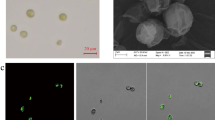Abstract
Vegetable oils were investigated to evaluate their potential to act as the sole carbon source for production of cephamycin C in shake and jar-fermentor cultures. Soybean oil was the best carbon source for cephamycin C production. Bioautography and HPLC analyses showed that cephamycin C was exclusively produced even when soybean oil was used as the sole cabon source. The optimal pH and initial concentration of soybean oil was 7.5 and 7 g/l, respectively. Both pH and the pH-control agent affected cephamycin C production, and among phosphoric acid, acetic acid and sulfuric acid, phosphoric acid was associated with the best production. Soybean oil was slowly consumed after the soluble nitrogen source was consumed. When the initial soybean oil concentration was 7 g/l, cephamycin C production was maximal, 2.0 g/l, which was twice as high as that from starch. The product yield from soybean oil was 4.7 times higher than that from starch. These results show that vegetable oils, which are cheaper than other carbon sources, could be used as the sole carbon source in the production of antibiotics.
Similar content being viewed by others
References
Aharonowitz Y, Demain AL (1978) Carbon catabolite regulation of cephalosporin production in Streptomyces clavuligerus. Antimicrob Agents Chemother 14:159–164
Chen HC, Wilde F (1991) The effect of dissolved oxygen and aeration rate on antibiotic production of Streptomyces fradiae. Biotechnol Bioeng 37:591–595
Dubois M, Gilles KA, Hamilton JK, Robers PA, Smith F (1956) Calorimetric method for determination of sugars and related substances. Anal Chem 28:350–356
Eiki H, Gushima H, Saito T, Ishida H, Oka Y, Osono T (1988) Product inhibition and its removal on josamycin fermentation by Streptomyces narbonensis var. Josamyceticus. J Fement Technol 66:559–565
Jensen EB, Nielsen R, Emborg C (1981) The influence of acetic acid on penicillin production. Eur J Appl Microbiol Biotechnol 13:29–33
Martin JF, Demain AL (1976) Control by phosphate of candicidin production. Biochem Biophys Res Commun 71:1103–1109
Masuma R, Tanaka Y, Omura S (1983) Ammonium ion-depressed fermentation of tylosin by the use of a natural zeolite and its significance in the study of biosynthetic regulation of the antibiotic. J Ferment Technol 61:607–614
Matsumura M, Imanaka T, Yoshida T, Taguchi H (1978) Effect of glucose and methionine consumption rates on cephalosporin C production by Cephalosporium acremonium. J Ferment Technol 14:159–164
Okabe M, Kuwajima T, Satoh M, Kimura K, Okamura K, Okamoto R (1992) Preferential and high-yield production of a cephamycin C by dissolved oxygen controlled fermentation. J Ferment Bioeng 73:292–296
Pan SC, Bonanno S, Wagman GH (1959) Efficient utilization of fatty oils as energy sources in penicillin fermentation. Appl Microbiol 7:176–180
Revilla G, Lopez-Niety MJ, Luengo JM, Martin JF (1984) Carbon catabolite repression of penicillin biosynthesis by Penicillin chrysogenum. J Antibiot 37:781–789
Schneider W (1945) Phosphorous compounds in animal tissues. I. Extraction and estimation of deoxypentose nucleic acid. J Biol Chem 161:293–295
Soltero and Johnson (1954) Continuous addition of glucose for evaluation of penicillin-producing cultures. Appl Microbiol 2:41–44
Tsunoda K (1993) Cephamycin C production using oils as the sole carbon source. B. Sc. thesis, Shizuoka University, pp 27–29
Vu-trong K, Bhuwapathanpun S, Gray PP (1981) Metabolic regulation in tylosin-producing Streptomyces fradiae: phosphate control of tylosin biosynthesis. Antimicrob Agents Chemother 19:209–212
Umezawa H (1982) Trends in antibiotic research and its expanded area. Antibiotics and low molecular weight immunomodifiers. In: Umezawa H (eds) Trends in antibiotic research. Japan Antibiotics Research Association, Tokyo, pp 1–15
Zanca DM, Martin JF (1983) Carbon catabolite regulation of the conversion of penicillin N into cephalosporin C. J Antibiot 36:700–708
Author information
Authors and Affiliations
Additional information
Correspondence to: M. Okabe
Rights and permissions
About this article
Cite this article
Park, Y.S., Momose, I., Tsunoda, K. et al. Enhancement of cephamycin C production using soybean oil as the sole carbon source. Appl Microbiol Biotechnol 40, 773–779 (1994). https://doi.org/10.1007/BF00173973
Received:
Revised:
Accepted:
Issue Date:
DOI: https://doi.org/10.1007/BF00173973




